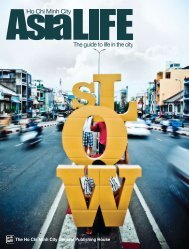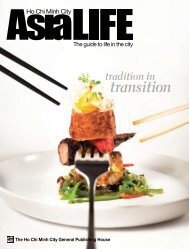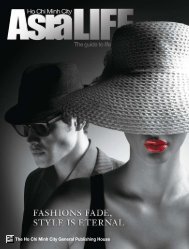Brett Davis - AsiaLIFE Magazine
Brett Davis - AsiaLIFE Magazine
Brett Davis - AsiaLIFE Magazine
Create successful ePaper yourself
Turn your PDF publications into a flip-book with our unique Google optimized e-Paper software.
Bong Bi<br />
Pumpkin flower<br />
Bong He<br />
Chive flowers<br />
Floral Flavours<br />
. . . . . . . . . . . . . . . . . . . . . . . . . . . . . . . . . . . . . . . . . .<br />
Bong Sung<br />
Water Lily<br />
Floral arrangements that pair perfectly with Vietnamese cuisine. By<br />
Beth Young. Researched by Stephy Thai. Image by Johnny Murphy.<br />
Bap Chuoi<br />
Banana flower<br />
Bong So Dua<br />
Pair chopsticks flowers<br />
Bong Dien Dien<br />
Sesbania sesban flowers<br />
Bong Thien Ly<br />
Fragrant cynanthe flowers<br />
Few Westerners scope out their<br />
local marketplace in search of<br />
edible flowers to bulk up their<br />
meals. Vietnamese, however,<br />
view the following flowers as<br />
delicacies. As such, these blossoms<br />
make appearances on special<br />
occasions like Tet, birthdays<br />
or the anniversary of a loved<br />
one’s death. Lack of celebration<br />
shouldn’t be a deterrent though.<br />
While some are seasonal, most<br />
are available year round and it’s<br />
definitely worth tempting your<br />
palate with these petals.<br />
Bong Bi<br />
Pumpkin flowers<br />
Bong bi is the male part of<br />
the pumpkin and as such the<br />
delicate yellow-hued flowers<br />
don’t bear fruit. The blossoms,<br />
however, can be boiled or fried<br />
and added to any number<br />
of Vietnamese dishes. Boiled<br />
bong bi is sweet with a slightly<br />
bitter aftertaste. To balance the<br />
flavour top it with braised fish<br />
or meat sauce or a spicy chilli<br />
and soy mixture. Otherwise, the<br />
blossoms are a great accompaniment<br />
to soups and garlic stirfries.<br />
Fried bong bi stuffed with<br />
finely ground shrimp, squid or<br />
lean meat and seasoned with<br />
green onion, salt, pepper and<br />
fish sauce, is purportedly the<br />
best way to down pumpkin<br />
flowers. The dish named bong<br />
bi nhoi thit chien is common in<br />
Southern Vietnam and Hue and<br />
is often prepared on special<br />
occasions like Tet or to commemorate<br />
a death. Bong bi are<br />
seasonal so be sure to grab a<br />
bundle if you see them.<br />
Bong Thien Ly<br />
Fragrant cynanthe flowers<br />
Bong thien ly come in two varieties:<br />
lemon-yellow and ivorywhite.<br />
Both are known for their<br />
tendency to share their sweet<br />
and fragrant scent when night<br />
falls and regardless of colour,<br />
are shaped like miniature wind<br />
chimes. The plant’s roots have<br />
medicinal properties and are<br />
said to heal bites and clear up<br />
urinary problems. The petals,<br />
however, are sweet and mild in<br />
flavour. Bong thien ly soup—<br />
the flower’s most common<br />
guise—is extremely simple<br />
to make. Soak bunches of the<br />
flowers in water to ensure all<br />
dirt and insects are removed<br />
then separate them. Cook the<br />
blossoms with minced meat,<br />
pounded field crab and ginger<br />
and soy sauce-marinated stirfried<br />
beef. The result is a fresh<br />
and light summer soup. Raw<br />
bong thien ly is also added to<br />
steaming hotpots.<br />
Bong He<br />
Chive flowers<br />
Bong he may be tiny but their<br />
healing properties are renowned.<br />
Cooked together with<br />
tofu it makes an antfebrile soup<br />
to relieve fevers and when stirfried<br />
with a chicken’s internal<br />
organs (heart, liver and gizzards)<br />
and saffron the miniscule<br />
buds help to soothe a persistent<br />
cough.<br />
Bong So Dua<br />
Pair chopsticks flowers<br />
Bong so dua are crescent-shaped<br />
white or purple flowers, whose<br />
petals sometimes curl downwards<br />
to resemble a pair of<br />
chopsticks—hence the name.<br />
These blooms are an acquired<br />
taste and one that fans can’t<br />
get enough of. Bong so dua<br />
blooms in October at the same<br />
time that linh fish is in season,<br />
giving rise to a soup that mixes<br />
both ingredients: canh chua ca<br />
linh bong so dua. To cook, rinse<br />
the flowers, then submerge in<br />
tamarind-flavoured boiling water<br />
together with the fish. Add<br />
spices to taste and lashings of<br />
crispy Vietnamese greens like<br />
ngo gai and rau om. Be careful<br />
not to overcook the flowers.<br />
They should be a little on the<br />
crunchy side. Ca loc boc bong<br />
so dua hap (steamed ca loc fish<br />
with pair chopstick flowers) is<br />
another popular dish.<br />
Bong Dien Dien<br />
Sesbania sesban flowers<br />
Mekong Delta residents eat<br />
bong dien dien raw or in sour<br />
linh fish soup. Otherwise, they<br />
eat the bright yellow flowers<br />
with bun mam (vermicelli<br />
noodle soup) or banh xeo (rice<br />
pancakes) and make dua chua<br />
(pickled vegetables) or goi<br />
(fresh spring rolls) with them.<br />
Bap Chuoi<br />
Banana flowers<br />
Known in the south as bap<br />
chuoi and in the north as bong<br />
chuoi, this purple flower is<br />
multi-purpose. It is used as a<br />
key ingredient in sour soup<br />
with shrimp, fish or eel and can<br />
be fried for a tasty treat. Most<br />
commonly though bap chuoi<br />
can be found in goi bap chuoi<br />
(banana blossom and squid<br />
salad) To make, cut the flowers<br />
into thin slices and soak them<br />
in water with a little lemon or<br />
vinegar. This will prevent the<br />
petals from discolouring and<br />
releasing any sap. After drying,<br />
mix with shrimp, boiled meat<br />
(either chicken or duck), rau<br />
ram (fragrant khotweed), onion<br />
and peanuts. Dress with fish<br />
sauce combined with sugar,<br />
lemon, garlic and chilli. Banana<br />
flowers also go nicely with bun<br />
rieu (crab meat noodle soup),<br />
bun bo (beef with vermicelli)<br />
and lau (hotpot).<br />
Bong Sung<br />
Water Lily<br />
Bong sung grows in any body<br />
of water, be it a pond, lake or<br />
canal, swamps or ditches (the<br />
latter, decidedly less appetizing).<br />
There are two varieties of<br />
bong sung: the large red-purple<br />
lotus and its smaller cousin the<br />
wild water lily, which is white.<br />
Bong sung is an exception to<br />
the other flowers mentioned<br />
here: its petals aren’t edible,<br />
just the stalk. Chunks of water<br />
lily stem (peeled and soaked<br />
first) are used as an ingredient<br />
in sour soup; eaten raw with<br />
braised fish and pickled in<br />
vinegar.<br />
44 asialife HCMC asialife HCMC 45















